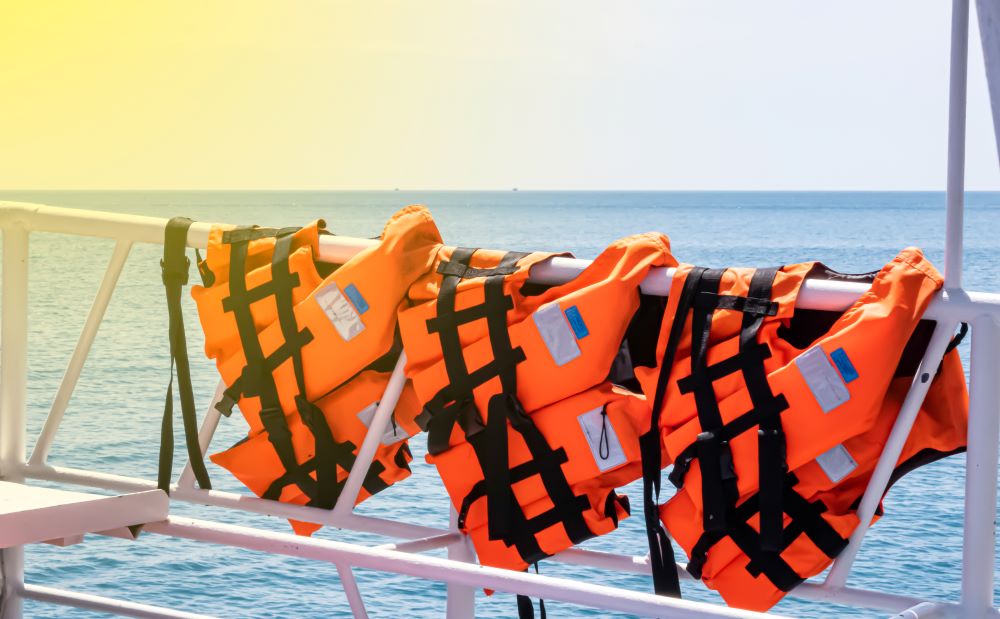
How to choose a life jacket
In Canada, personal flotation devices (PFDs) are mandatory on all marine vessels, whether motorized or not. If you want to go out on the water, you must wear a government-approved life jacket with a label showing this.
You can also buy PFDs made abroad, but they must meet Canadian boating safety standards. Before purchasing a PFD, it is necessary to take into account certain requirements to ensure that the PFD is safe.
Certified by Transport Canada for offering an official Canadian boat safety course, the National Boating Safety School team gives you all the information you need to choose a safe life jacket!
What should I look for when choosing a life jacket?
As stated above, there are certain requirements to consider before choosing a life jacket. These are based on various safety aspects that must be respected for the persons boating with you.
Discover these different requirements below!
Fit of the life jacket
The fit is the most important element in choosing your PFD. An improperly fitted life jacket is not only uncomfortable and unlikely to be worn, but it may not provide the best protection for the wearer. This could lead to tragic consequences in the event of an accident.
Make sure the life jacket fits the wearer’s body properly. Adjust the straps and raise the PFD to see if it slips slightly. If it does, readjust it until it no longer slips. A PFD that slips can be cumbersome and dangerous in the ocean or other body of water.
To estimate the fit of a life jacket, check if you have enough room under your armpits to move as naturally as possible. Once you are wearing it, experiment with various movements to see how well it fits.
Where the PFD will be used
One of the other things to consider when choosing your life jacket is where it will be used. PFDs designed for whitewater activities are shorter than those used in freshwater. There are fewer pockets on these jackets to maximize freedom of movement.
In general, approved PFDs are legal for both freshwater and marine use. However, inflatable PFDs are not permitted for whitewater activities.
When you study for the Canada boating exam online, you will learn how to use your PFD in different types of water and in emergency situations.
CO2 cartridge
Inflatable PFDs have a compressed CO2 cartridge, which is activated by a manual trigger or mouth inflator.
Because of these limitations, inflatable PFDs are not permitted for whitewater kayakers. Once empty, the cartridge must be replaced and the activation mechanism will require regular maintenance. The main advantages of this life jacket are its space-saving fit and its ability to keep you cool.
Buoyancy of the life jacket
Just like boats, buoyancy is an important criterion to consider when choosing a life jacket. If you’re sailing on a lake or in the ocean, you may want to consider a PFD with a higher buoyancy rating to help you stay afloat in the big waves. Some PFDs are not as buoyant in fresh water as they are in salt water.
In order to have good buoyancy, the flotation jacket must be designed in such a way that it does not come up to the wearer’s face. In addition, some PFDs may be equipped with padding to minimize muscle fatigue in the shoulders.
How to care for a life jacket
To properly maintain your life jacket, it must be protected from abrasion and material compression. To do this, clean it by hand with a little soap and warm water. To reduce the risk of mildew, dry your jacket and store it out of the sun in a dry place if possible.
Floatation jackets are an investment in your safety and should be treated as such. Caring for them will ensure that you have a reliable way to stay afloat in any condition!
Learn more about life jackets and PFDs from the National Boating Safety School
Whether you want to navigate on Canadian waters or on rough seas, wearing a life jacket is necessary and mandatory. Following the above guidelines will help you choose the right PFD for your needs and ensure a proper fit.
If you would like to learn more about PFDs and water safety in general, check out the National Boating Safety School’s blog section for more resources.
Please contact us if you have any other questions! We are here to facilitate your efforts and will be happy to answer any questions you may have.

